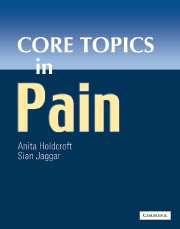Book contents
- Frontmatter
- Contents
- Contributors
- Preface
- Acknowledgements
- Foreword
- General abbreviations
- Basic science abbreviations
- PART 1 BASIC SCIENCE
- PART 2 PAIN ASSESSMENT
- Section 2a Pain measurement
- Section 2b Diagnostic strategies
- PART 3 PAIN IN THE CLINICAL SETTING
- Section 3a Clinical presentations
- 14 Epidemiology of pain
- 15 Pain progression
- 16 Analgesia in the intensive care unit
- 17 The chronic pain patient
- 18 Post-operative pain management in day case surgery
- Section 3b Pain syndromes
- PART 4 THE ROLE OF EVIDENCE IN PAIN MANAGEMENT
- PART 5 TREATMENT OF PAIN
- Section 5a General Principles
- Section 5b Physical treatments
- Section 5c Pharmacology
- Section 5d Psychosocial
- PART 6 SUMMARIES
- Glossary
- Index
17 - The chronic pain patient
from Section 3a - Clinical presentations
Published online by Cambridge University Press: 10 December 2009
- Frontmatter
- Contents
- Contributors
- Preface
- Acknowledgements
- Foreword
- General abbreviations
- Basic science abbreviations
- PART 1 BASIC SCIENCE
- PART 2 PAIN ASSESSMENT
- Section 2a Pain measurement
- Section 2b Diagnostic strategies
- PART 3 PAIN IN THE CLINICAL SETTING
- Section 3a Clinical presentations
- 14 Epidemiology of pain
- 15 Pain progression
- 16 Analgesia in the intensive care unit
- 17 The chronic pain patient
- 18 Post-operative pain management in day case surgery
- Section 3b Pain syndromes
- PART 4 THE ROLE OF EVIDENCE IN PAIN MANAGEMENT
- PART 5 TREATMENT OF PAIN
- Section 5a General Principles
- Section 5b Physical treatments
- Section 5c Pharmacology
- Section 5d Psychosocial
- PART 6 SUMMARIES
- Glossary
- Index
Summary
Chronic pain is defined by the International Association for the Study of Pain (IASP), as pain that persists for longer than the time expected for healing, or pain associated with progressive, non-malignant disease. Often chronic pain persists long after the tissue damage that initially triggered its onset has resolved; it may present without any identified ongoing tissue damage or antecedent injury.
Chronic pain serves no purpose and often makes no sense. It is often unrelated to tissue damage and does not warn the individual of injury or disease. Overall the experience is distressing and frustrating, as the pain does not respond to the usual treatments for acute pain, such as analgesics, rest, taking time off work and seeking medical advice.
Different people respond differently to the experience of pain. How an individual responds depends upon their gender, age, culture and previous experience of pain. Some chronic pain patients who present with specific nerve damage or disease may be able to cope with their pain, however, others may go on and develop characteristics that are referred to as the ‘chronic pain syndrome’ (Hanson and Gerber, 1990).
Chronic pain includes the following:
history of unsuccessful treatments.
level of physical disability exceeding that expected.
Psychosocial problems, such as depression, anxiety, anger, sleep loss, loss of pleasure from normal activities and a preoccupation with pain.
- Type
- Chapter
- Information
- Core Topics in Pain , pp. 117 - 120Publisher: Cambridge University PressPrint publication year: 2005



